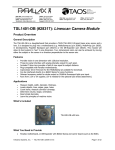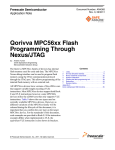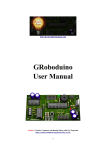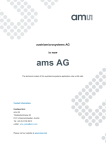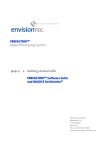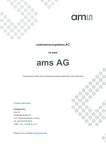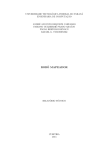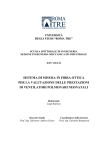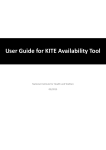Download Projekt Raport z budowy robota na zawody The Freescale Cup 2012
Transcript
Sterowniki robotów - Projekt Raport z budowy robota na zawody The Freescale Cup 2012 Autorzy: Przemysław Jankowski, Przemysław Kochański Wrocław 2012 Table of contents: 1 Introduction 2 2 Mechanics 3 2.1 Chassis . . . . . . . . . . . . . . . . . . . . . . . . . . . . . . . . . . . . . . 3 2.2 Body . . . . . . . . . . . . . . . . . . . . . . . . . . . . . . . . . . . . . . . 4 2.3 Camera and headlights . . . . . . . . . . . . . . . . . . . . . . . . . . . . . 4 3 Electronics 4 3.1 MCU Board . . . . . . . . . . . . . . . . . . . . . . . . . . . . . . . . . . . 4 3.2 Bluetooth module . . . . . . . . . . . . . . . . . . . . . . . . . . . . . . . . 6 3.3 Motor Control Board . . . . . . . . . . . . . . . . . . . . . . . . . . . . . . 6 3.4 Monitoring the battery . . . . . . . . . . . . . . . . . . . . . . . . . . . . . 6 3.5 Encoders . . . . . . . . . . . . . . . . . . . . . . . . . . . . . . . . . . . . . 7 3.6 Camera . . . . . . . . . . . . . . . . . . . . . . . . . . . . . . . . . . . . . 7 3.7 Additional lighting . . . . . . . . . . . . . . . . . . . . . . . . . . . . . . . 8 3.8 Electrical noise suppression . . . . . . . . . . . . . . . . . . . . . . . . . . 9 3.9 Power consumption . . . . . . . . . . . . . . . . . . . . . . . . . . . . . . . 9 4 Software 10 4.1 Following the line . . . . . . . . . . . . . . . . . . . . . . . . . . . . . . . . 10 4.2 Speed control system . . . . . . . . . . . . . . . . . . . . . . . . . . . . . . 10 4.3 Debuging . . . . . . . . . . . . . . . . . . . . . . . . . . . . . . . . . . . . 10 4.4 Differential control of motors . . . . . . . . . . . . . . . . . . . . . . . . . . 11 4.5 Automatic light calibration . . . . . . . . . . . . . . . . . . . . . . . . . . . 11 5 Summary 12 Bibliography 12 1 Team name: A whole lot of left handed space monkeys with razor-sharp teeth and unpleasant attitude Team members: Przemysław Kochański, Maciej Mucha, Przemysław Jankowski Car’s name: Johnny Figure 1: Johnny - the autonomous car 1 Introduction Johnny is an autonomous, line following car, which was made for Freescale Cup 2012. The goal of a robot during tournament is to ride along the black line towards the finishing line in the shortest possible time. The obstacles like tunnels, elevations and unevenness of the road may occur and the car has to be ready for them. Robot has to be completely autonomous and has to stop after completing two laps. Johnny was built by three students 2 of Wroclaw University of Technology. The construction is based on parts provided by Freescale. 2 Mechanics Johnny is a simple model of a car. It has one driving axis (both rear wheels can be controlled separately though thanks to two DC motors) and one turning axis. It consists of 3 main sections - chassis, body and a grip holding camera and headlights. 2.1 Chassis Mechanical design of the robot is based on stock plastic chassis provided by Freescale. It is 285mm long and 160mm wide. There are two DC motors located at the rear section of the chassis. They propel the wheels using simple gear system. On the middle of the chassis a Ni-MH battery is situated ensuring that the center of mass is situated low. There is also one servo located on the front section of the chassis, right behind the bumper. It is responsible for turning front wheels. Figure 2: Provided chassis 3 2.2 Body A rectangular piece of plexiglass (185x130x3mm) has been added to hold the MCU board and motor control board. All of these parts are the body of the car. 2.3 Camera and headlights Camera is located 200mm above the ground. Two pieces of an office ruler, which are attached to the chassis with screws hold it. The camera needs an extra light, which also has been provided. A piece of PCB containing LEDs is attached to the rulers below the camera. It is 280mm wide. Figure 3: Headlights of the car 3 Electronics Control circuit of the car is divided amongst two boards - both provided by Freescale. 3.1 MCU Board The TRK-MPC5604b board was provided by Freescale and has not been modified in any way. The board didn’t contain MAX232 driver/receiver, so on board Virtual Serial Port was connected to processor’s SCI RXD/TXD and USB port was used to receive serial transmission. Later, when bluetooth module was added, Virtual Serial Port was redundant. 4 Figure 4: MCU board’s schematic, pin-outs and size 5 3.2 Bluetooth module In order to better understand behavior of the car and to debug it easily a bluetooth module has been used. It provided wireless communication between PC and microcontroller in distance around 10m. Written software allowed car’s speed and each PID regulator term’s gain to be changed wirelessly using PC. 3.3 Motor Control Board Motor Control Board (MCB), provided by freescale, includes two H-bridges MC33931, two LM2940 5V regulators - one for servo supply and one for logic supply. The motor control board has been modificated in order to allow braking. The IN1 pins of left and right H-bridge were desoldered form the GND, lifted up and connected to MCU pins PA14 and PA15, which were set as output in order to enable braking by setting IN1 and IN2 High. Braking distance was decreased from over 3m to under 1m. Figure 5: Modded MCB 3.4 Monitoring the battery To monitor the battery a 1:2 voltage divider has been used. Divided voltage is measured by analog-digital converter of the microcontroller. 6 3.5 Encoders To achieve the same speed regardless of voltage on the discharging battery, an AS5040 magnetic rotary encoder was mounted near the each motor’s rotor. 2x6mm round magnets were glued to each rotor in order to provide magnetic field rotation to the encoders when driving. The software PID regulator controls the motors’ PWM to achieve the desired rotational speed, which allowed to maintain the same performance of the software regulator used to follow the line regardless of battery voltage. Figure 6: Encoder’s connection diagram 3.6 Camera The TSL1401R-LF camera, provided by Freescale, was used to determine the line position. It has the resolution of 128 x 1 pixels. By setting a CLK signal low and then high, next pixel’s analog value (2-5V) is send to MCU’s ADC0. The more light each pixel receives, the higher the voltage is. Process repeats until all pixels are read. 7 Figure 7: Mounted encoder’s PCB 3.7 Additional lighting Extra light was required in order to achieve high contrast of area seen by the camera. It has been provided by an array of 37 LEDs attached to the front of the car. Each LED has a 20 degrees of lighting angle and consumes 30mA. LEDs are powered from 5V 2A 78s05 voltage regulator. Although adding the LEDs has increased the power consumption by over 1.1A, camera’s exposure time could have been reduced over 6 times. Figure 8: Headlights’ connection diagram 8 3.8 Electrical noise suppression Due to poor design of Motor Control Board - especially analog camera signal and GDN going through the same board as high motor current - AD0 signal from camera was receving strong interference. In order to suppress it, two 100nF capacitors were added to each motor. One side of each capacitor was soldered to one of the motor’s terminal and other side was soldered to the motor’s case as shown on the picture below. Additional 100nF capacitor was added parallel between camera’s VCC and GND for further noise filtering. Provided filters eliminated all electrical noise. Figure 9: Noise reducing capacitors 3.9 Power consumption Adding headlights to a car increased power consumption significantly. Every single LED needs 30mA and there are 37 of them, so 1,1A current on 5V is needed. That makes 5,5W of power used only for LEDs. It makes the battery voltage decreasing quite fast. Additionally the battery has been once discharged below the level of safety. The voltage fell to under 5V, which reduced the battery capacity and resulted in even more rapid discharge. Car’s engines and logic power consumption (without lights) when driving is 0,7A on 8V - that gives 5,6W. Total power consumption is about 11,1W. 9 4 Software 4.1 Following the line A provided 1D camera is the only sensor installed. It allows robot to follow the line. After acquiring data from the camera, a derivative is calculated. Then rising and falling edges of the function are being found, the biggest represent the edges of the black line. Every single pixel has its weight, which is a base of calculating error. Robot has a PD regulator algorithm implemented, which calculates control. This causes appropriate front axis inclination. By changing gains of proportional and differential terms (tuning the regulator) and matching them to desired speed and route conditions stable line-following can be achieved. 4.2 Speed control system Installed encoders allowed precise speed control. PD speed regulator was needed in order to achieve it. Signals from encoders are sent to MCU counter, and from there, as negative feedback loop, to software PD regulator. Figure 10: Speed control system 4.3 Debuging A dedicated C# application has been developed in order to debug the robot’s algorithm using PC. It receives data from car through bluetooth and shows such informations like 10 current error and regulator’s settings. It also allows to tune the regulator and change robot’s speed on-line. This was not used during the tournament though because the robot had to be completely autonomous. Figure 11: Screenshot from the described application 4.4 Differential control of motors In the first version of a car prototype both motors’ speeds were always equal and the front axis inclination was the only way to turn. Since it was not sufficient at high speed an improvement had to be developed. Present version of software allows robot to set different speed on each motor which helps at sharp turns. 4.5 Automatic light calibration Automatic software calibration which bases on current light level changes the camera pixels integration time constantly. It allows the car to drive independently of external light conditions and maximize frequency of line position measurements. 11 5 Summary After a few weeks of work a well operating and fast robot has come to being. It is able to follow the line accurately even on high speed, which proves the correctness of the algorithm. Johnny managed to end the Freescale Cup 2012 on the third place. Although some problems occurred, creating a robot provided the constructors a lot of satisfaction and knowledge. The work on the robot isn’t over though. The next step is to increase its speed even more and to create reliable body for the car in order to protect its components and to improve its design. Bibliography [1] Francisco Ramirez Fuentes, Marco Trujillo, Cuauhtli Padilla, Rodrigo Mendoza, Using Parallax TSL1401-DB Linescan Camera Module for line detection, Freescale Semiconductor, Document Number: MPC5604B, Rev. 0, 01/2011 [2] Freescale Semiconductor, The Freescale Cup 2011-2012 Season Rules EMEA, Release date 03May2011 [3] Freescale Semiconductor, MC33931, 5.0 A Throttle Control H-bridge Document Number: MC33931, Rev. 2.0, 12/2008 [4] TAOS inc. TSL1401CL, 128 x 1 Linear Sensor Array With Hold, TAOS136 - July 2011 [5] The Freescale Cup wiki, http://thefreescalecup.wikidot.com/ [6] Freescale Semiconductor, MPC5604B/C Microcontroller Reference Manual, MPC5604BCRM, Rev. 8, 5 May 2011 [7] Freescale Semiconductor, MPC5500 & MPC5600 Simple Cookbook, AN2865, Rev. 4, 04/2010 [8] PE micro, TRK-MPC5604B EVB User Manual, 2010 P & E Microcomputer Systems 12













